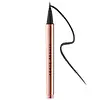Fenty Beauty Flyliner Longwear Liquid Eyeliner Versus Benefit Cosmetics BROWVO! Conditioning Eyebrow Primer
What's inside
What's inside
 Key Ingredients
Key Ingredients

No key ingredients
 Benefits
Benefits

 Concerns
Concerns

 Ingredients Side-by-side
Ingredients Side-by-side

Water
Skin ConditioningButylene Glycol
HumectantStyrene/Acrylates Copolymer
Acrylates Copolymer
Styrene/Acrylates/Ammonium Methacrylate Copolymer
Beheneth-30
CleansingPentylene Glycol
Skin ConditioningAlcohol
AntimicrobialCaprylyl Glycol
Emollient1,2-Hexanediol
Skin ConditioningEthylhexylglycerin
Skin ConditioningSodium Laureth-12 Sulfate
CleansingDisodium EDTA
C11-15 Pareth-7
EmulsifyingTetrasodium EDTA
Phenoxyethanol
PreservativeSodium Dehydroacetate
PreservativePotassium Sorbate
PreservativeCI 77266
Cosmetic ColorantWater, Butylene Glycol, Styrene/Acrylates Copolymer, Acrylates Copolymer, Styrene/Acrylates/Ammonium Methacrylate Copolymer, Beheneth-30, Pentylene Glycol, Alcohol, Caprylyl Glycol, 1,2-Hexanediol, Ethylhexylglycerin, Sodium Laureth-12 Sulfate, Disodium EDTA, C11-15 Pareth-7, Tetrasodium EDTA, Phenoxyethanol, Sodium Dehydroacetate, Potassium Sorbate, CI 77266
Water
Skin ConditioningAlcohol Denat.
AntimicrobialLithium Magnesium Sodium Silicate
AbsorbentPentylene Glycol
Skin ConditioningHydrolyzed Keratin
HumectantPhenoxyethanol
PreservativeBenzyl Alcohol
PerfumingXanthan Gum
EmulsifyingCaprylyl Glycol
EmollientStyrene/Acrylates/Ammonium Methacrylate Copolymer
Panthenol
Skin ConditioningDisodium EDTA
Butylene Glycol
HumectantHydrolyzed Soy Protein
HumectantSodium Laureth-12 Sulfate
CleansingC11-15 Pareth-7
EmulsifyingOlea Europaea Fruit Oil
MaskingSimmondsia Chinensis Seed Oil
EmollientTocopheryl Acetate
AntioxidantPotassium Sorbate
PreservativeTetrasodium EDTA
Water, Alcohol Denat., Lithium Magnesium Sodium Silicate, Pentylene Glycol, Hydrolyzed Keratin, Phenoxyethanol, Benzyl Alcohol, Xanthan Gum, Caprylyl Glycol, Styrene/Acrylates/Ammonium Methacrylate Copolymer, Panthenol, Disodium EDTA, Butylene Glycol, Hydrolyzed Soy Protein, Sodium Laureth-12 Sulfate, C11-15 Pareth-7, Olea Europaea Fruit Oil, Simmondsia Chinensis Seed Oil, Tocopheryl Acetate, Potassium Sorbate, Tetrasodium EDTA
Ingredients Explained
These ingredients are found in both products.
Ingredients higher up in an ingredient list are typically present in a larger amount.
Butylene Glycol (or BG) is used within cosmetic products for a few different reasons:
Overall, Butylene Glycol is a safe and well-rounded ingredient that works well with other ingredients.
Though this ingredient works well with most skin types, some people with sensitive skin may experience a reaction such as allergic rashes, closed comedones, or itchiness.
Learn more about Butylene GlycolAnother name for this ingredient is C11-15 Alketh-7. It has emulsifying and surfactant properties, meaning it helps keep ingredients together in a formula.
Caprylyl Glycol is a humectant and emollient, meaning it attracts and preserves moisture.
It is a common ingredient in many products, especially those designed to hydrate skin. The primary benefits are retaining moisture, skin softening, and promoting a healthy skin barrier.
Though Caprylyl Glycol is an alcohol derived from fatty acids, it is not the kind that can dry out skin.
This ingredient is also used as a preservative to extend the life of products. It has slight antimicrobial properties.
Learn more about Caprylyl GlycolDisodium EDTA plays a role in making products more stable by aiding other preservatives.
It is a chelating agent, meaning it neutralizes metal ions that may be found in a product.
Disodium EDTA is a salt of edetic acid and is found to be safe in cosmetic ingredients.
Learn more about Disodium EDTAPentylene glycol is typically used within a product to thicken it. It also adds a smooth, soft, and moisturizing feel to the product. It is naturally found in plants such as sugar beets.
The hydrophilic trait of Pentylene Glycol makes it a humectant. As a humectant, Pentylene Glycol helps draw moisture from the air to your skin. This can help keep your skin hydrated.
This property also makes Pentylene Glycol a great texture enhancer. It can also help thicken or stabilize a product.
Pentylene Glycol also acts as a mild preservative and helps to keep a product microbe-free.
Some people may experience mild eye and skin irritation from Pentylene Glycol. We always recommend speaking with a professional about using this ingredient in your routine.
Pentylene Glycol has a low molecular weight and is part of the 1,2-glycol family.
Learn more about Pentylene GlycolPhenoxyethanol is a preservative that has germicide, antimicrobial, and aromatic properties. Studies show that phenoxyethanol can prevent microbial growth. By itself, it has a scent that is similar to that of a rose.
It's often used in formulations along with Caprylyl Glycol to preserve the shelf life of products.
Potassium Sorbate is a preservative used to prevent yeast and mold in products. It is commonly found in both cosmetic and food products.
This ingredient comes from potassium salt derived from sorbic acid. Sorbic acid is a natural antibiotic and effective against fungus.
Both potassium sorbate and sorbic acid can be found in baked goods, cheeses, dried meats, dried fruit, ice cream, pickles, wine, yogurt, and more.
You'll often find this ingredient used with other preservatives.
Learn more about Potassium SorbateSodium Laureth-12 Sulfate is a type of sulfate.
We don't have a description for Styrene/Acrylates/Ammonium Methacrylate Copolymer yet.
Tetrasodium EDTA is the salt formed from neutralizing ethylenediamine tetraacetic acid with sodium hydroxide. It is a chelating agent and used to prevent metal ions from binding to other ingredients. This helps keep the product and ingredients stable.
Tetrasodium EDTA comes as a white solid and is soluble in water.
Water. It's the most common cosmetic ingredient of all. You'll usually see it at the top of ingredient lists, meaning that it makes up the largest part of the product.
So why is it so popular? Water most often acts as a solvent - this means that it helps dissolve other ingredients into the formulation.
You'll also recognize water as that liquid we all need to stay alive. If you see this, drink a glass of water. Stay hydrated!
Learn more about Water